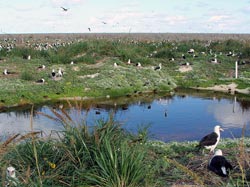
Physical Feature: Fresh water lens
Access to fresh water is the primary limiting factor for terrestrial plants and animals living on the small Northwestern Hawaiian Islands. Atolls, and other low-lying islands in the Pacific, have a hydrologic feature, called a freshwater lens, that allow many of terrestrial species to survive. Freshwater is less dense than seawater, and rainfall that percolates through the sand and coral rubble composing the islands forms a convex lens that floats atop the seawater. The size of the lens is determined by the size of the terrestrial catchment area, precipitation, and saltwater inundation. The lenses can be as shallow as 4-8 inches, or as deep as 65 feet. On Midway, the proximity of the lens to the surface allowed Fish and Wildlife Service Refuge staff to dig shallow trenches in the sand that filled with freshwater, and provided a habitat for translocated Laysan ducks. It is quite an unexpected sight to see these small wetlands on the atoll, and the many happy ducks. I have even seen the albatross paddling lazily in these oases, flanked by bewildered ducks. Changes in precipitation patterns, and sea level rise due to climate change are a major concern for Pacific communities that depend on these freshwater lenses for survival.

